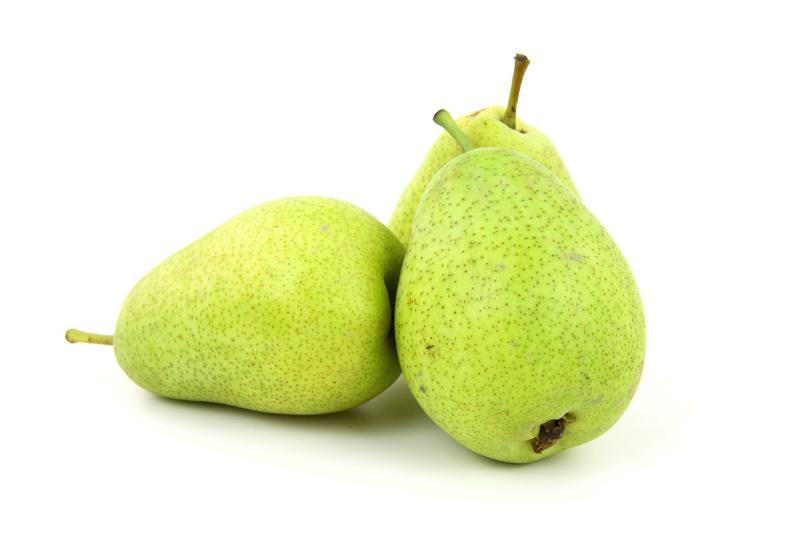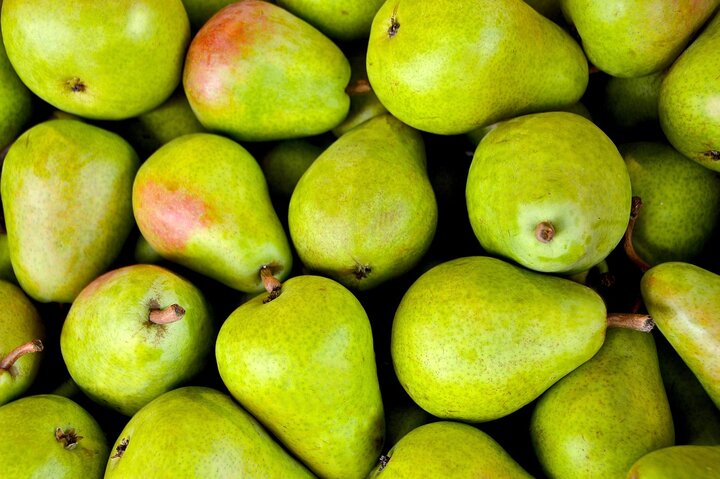Sarah Browning, Nebraska Extension Educator

Knowing when to harvest pears is confusing to many gardeners, because tree ripened pears often do not usually have good quality. They develop stone or grit cells, or a mealy texture that makes the fruit less desirable. Pears ripen from the inside out, a characteristic more pronounced in tree ripened fruits. So when the outside flesh has become slightly soft and appears to have good eating quality, the inside flesh is soft and brown.
Tree ripened fruits have shorter shelf and storage life, which may be particularly true this year with summer's continued high temperatures. Fruits left on the tree too long will go quickly from slightly under-ripe to rotting.
For good flavor and texture, pears must be ripened after harvest. Completing the ripening process indoors reduces the development of stone cells and evens the ripening of interior and exterior flesh.

When to Harvest
Harvest pears while they are still quite firm (hard) but the skin color, or 'ground color', has lightened to a pale green or greenish-yellow color. Ground color is the color of a pear's skin, disregarding any areas that have become red. Don't allow pears to become fully yellow on the tree before harvesting. Additional indications that pears are ready to harvest are when the fruit stem easily separates from the branch with an upward twist of the fruit and when the lenticels (spots on fruit surface), which are white or green on immature fruits, become brown.
Most pear cultivars can be easily removed from the tree when they are ready to harvest. Grasp a fruit, and tilt it to a horizontal or upward position to detach its stem from the tree. 'Bosc' pears, however, usually need to be clipped from the tree with pruners, even when they have reached maturity.
Ripening Indoors
After harvest, pears should be held at 60 to 65 degrees F for 1 to 3 weeks, depending on the type of pear. During this time the pears will ripen and soften. High temperatures (75 degrees F and higher) after picking will cause the fruit to break down without ripening. After ripening, pears should be canned or preserved.
Storage
To keep pears longer in storage, do not allow them to ripen after harvest. Sort the immature pears for defects, discarding any with bruises, mechanical damage or insect damage, then place them into cold storage at 29-31 degrees F and 90% humidity. Perforated plastic bags or partially sealed plastic containers can be used to store small groups of fruit while maintaining high humidity but allowing gas exchange of ethylene, which hastens ripening. Store pears away from apples, onions, potatoes or any other ethylene-producing fruits or vegetables.
Regularly inspect stored fruits for mold, and fruit breakdown. Pears in a good storage environment should last 2-4 months.
Ripen small amounts as needed, by moving them to a warmer location, 60-65°F, for a few days.
Images by Pixabay.com.
Search Our Archive
Associated Video
Pear Rust
Nebraska Extension Plant Diagnostician Kyle Broderick talks about the causes of pear rust and how you can manage your pear trees to avoid it.